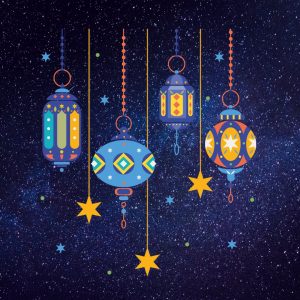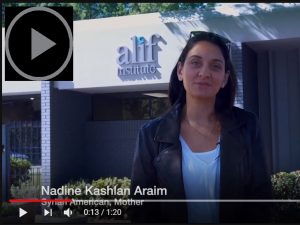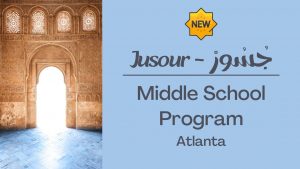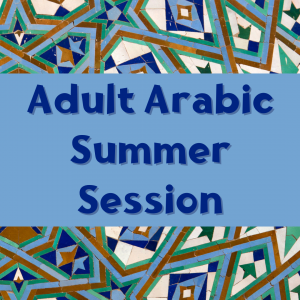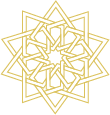
Summer 2021 Arabic Courses
This summer we are offering two NEW programs in addition to our regular summer Arabic line-up:

Alif Institute is the only non-profit, non-religious, and non-political Arab-American cultural center in the southeast and one of its kind among the National Network of Arab American Communities (NNAAC). We are known regionally and nationally for our cultural and linguistic programming, community engagement, and annual Arab-American Festival.
Located in Atlanta, Georgia, we have access to diverse Arabic-speaking communities from several generations, backgrounds, identities, and affiliations. Our mission is to foster the education and appreciation of Arab cultures. In our Arabic programs, you not only learn about Arabic literary contributions, grammar, and how to pass a test in a classroom, but also and more importantly, you learn to interact with a diverse array of Arabic-speakers and Arab-Americans in everyday settings, how to navigate grocery stores, order at restaurants, proper conduct during home invitations, professional business settings, at the doctor’s office, etc. while learning to cook, write calligraphy, listen and play music, in a transformative curriculum were you acquire a critical understanding of history and stereotypes, developing your intercultural and global competence skills, and not shying away from the hard questions.
Alif is also a partner for many organizations such as the QFI Arabic Teachers Council of the Southeast, Georgia Arabic Teachers Association, Georgia Arabic Student Association, etc. As a community member of the Greater Atlanta Coalition for Global Education and Research (GAcGEAR), we are committed to graduating students with global competence, ready to compete in the 21st-century workforce.
Per the GAcGEAR, Global competence is the ability to:
- Communicate in the language of the people with whom one is interacting.
- Interact with awareness, sensitivity, empathy, and knowledge of the perspectives of others.
- Withhold judgment, examining one’s own perspectives as similar to or different from the perspectives of people with whom one is interacting.
- Be alert to cultural differences in situations outside of one’s culture, including noticing cues indicating miscommunication or causing an inappropriate action or response in a situation.
- Act respectfully according to what is appropriate in the culture and the situation where everyone is not of the same culture or language background, including gestures, expressions, and behaviors.
- Increase knowledge about the products, practices, and perspectives of other cultures.
Global competence is developed and demonstrated by investigating the world, recognizing and weighing perspectives, acquiring and applying disciplinary and interdisciplinary knowledge, communicating ideas, and taking action.
Global competence is a critical component of education in the 21st century, as reflected in national initiatives focused on literacy and STEM at the PK-12 level and included in the essential learning outcomes of the Liberal Education and America’s Promise (LEAP) program of the Association of American Colleges and Universities (AAC&U).
With these goals in mind, we have created a new lineup of summer programming to break the monotony caused by the pandemic. Click below to learn more about our:
- multi-destination study abroad program for college students
- domestic intensive program for high school and college students
- domestic summer programs for middle school students
- customized programs
- regular course offerings
- supplemental programming for K-20 and other institutions
The field of Teaching Arabic as a Foreign Language (TAFL) in the US had advanced exponentially since WWII when the US entered the field as an imperial superpower. There remain, however, several unaddressed or understudied problems and gaps in the field for 21st-century TAFL. The field is still in a hotly contested debate of diglossia which plays itself out in the classroom, curriculum, and conferences in the separate and unequal, separate but equal, and together but relationship status ‘complicated,’ and the holistic approach to Modern Standard Arabic versus Arabic dialects, and the new multilingual turn. Among the unaddressed or understudied problems in TAFL is the absence of criticality and lack of alignment between curriculum, study abroad destination, ACTFL proficiency exams, adapting the field to meet student motivations for enrolling in Arabic, strict adherence to dated theories, etc. Understanding and addressing these problems are at the root of what makes our program unique. Arabic is taught in the natural way Arabic-speakers communicate with each other across the ‘Arabic as One Language Model,’ whether spoken in various formal and informal settings, written with or without editorial oversight, and posted or sent digitally on social media mobile apps. We advance the communicative approach by incorporating critical intercultural citizenship, community-based experiential learning, and culturally and historically responsive pedagogies.
Generally speaking, Modern Standard Arabic (MSA) is a form of Arabic used to interact with books and official mediums of communication (legal documents, news, etc), most of which require an editor. MSA is not a language anyone grows up speaking, rather it is a language that is acquired through formal schooling. The more fluent and fluid one speaks or writes MSA, the more educated one presents themselves. However, when MSA is used in everyday contexts, it may not be understood and, in most regions, sounds like you are speaking Shakespearian English while ordering coffee at a cafe.
Arabic dialects are forms of Arabic spoken by Arabic speakers at home and in everyday scenarios. Dialects vary from one region to another with many sub-dialects also present. The further the dialect regions are from each other thee more of a chance they have of not being fully understood. Generally speaking, Arabic dialects are traditionally not taught in school and required immersion among locals.
Since both MSA and Arabic dialects are living languages, and basic science tells us that everything that is living is in a state of constant change, so are these languages. Classical Arabic was in this state of constant change until its vocabulary became frozen to the medieval period. Classical Arabic is still used today (especially in sermons, to access older works, write classical poetry) and MSA is a modern form of the Classical written language. In the Arabic-speaking world, Classical and MSA are lumped together in one term known as fuṣḥā.
To be highly proficient in Arabic for everyday and professional settings, one is required to be fluent in a dialect and have various degrees of fluency in MSA and Classical Arabic. The field of Teaching Arabic as a Foriegn Language (TAFL) remains split between what Arabic should be taught and when. The integrated approach combining dialect and MSA is gaining popularity in the US and Europe. New to the field as well is the turn toward multilingualism. Interesting and exciting times lie ahead for the field.
So, what dialect should you learn? The answer lies in which population you wish to interact with the most. If it’s only books, then MSA and Classical. If it is people, know that Arabic speakers communicate across dialects through multilingual and cross dialect code-switching which may or may not incorporate MSA and non-Arabic languages. Arabic, as a living language, is also going through a process of mother tongue-based cross-spectrum communicative hybridization known as al-lahjah al-bayda’. Rarely, if any, is MSA alone used in these everyday contexts among Arabic-speakers as a whole. But the more MSA you know, on top of a dialect or dialects, reflects the more educated you are. Arabic speakers pepper their every day with MSA and Classical Arabic to sound formal and authoritative, similar to how American English speakers interpolate French or Latin phrases or terms.
Before Islam, Arabic was spoken predominately on the periphery and semi-periphery of the Fertile Crescent into the Arabian Peninsula. We do not know how old Arabic is. However, scholarly evidence dates Arabic as early as the 3rd century BCE. Be mindful that some people will contend that Arabic dates back to the assembly of Angels before the Almighty and spoken by Adam and Eve. Recent archaeological evidence by Ahmad Al-Jallad sheds new light on Pre-Islamic Arabic scripts as found on rock inscriptions in the Syrian Desert. Watch his fascinating lecture on The Rise of Arabic for more details. After the emergence of Islam in the 7th century, when Arabic became a world language and repository of human intellectual endeavors, Arabic script developed in two main trajectories. In the 8th century, paper production was introduced to Baghdad via China. Here is a video of the history of paper in China, Baghdad and the Papermaking Industry, and readings from PBS Islam Empire of Faith: Paper and Publishing, The Role of the Arabs in the Introduction of Paper to Europe, An Empire Built on Paper. The introduction of paper in Baghdad happened alongside one of the peaks in human intellectual history, which occurred in the Islamic Golden Age between the 8th to the 14th centuries and whose works would help give rise to the European Renaissance in the 15th and 16th centuries.
On the one hand, scribes needed to invent a fast to write script to keep up with the demand for books. For example, see Ibn Al-Nadim’s medieval book catalog, called al-Fihrist, which lists over 10,000 books for sale on a wide range of topics with biographies on the authors. (notice a trend where the Arabic and Islamicate contributions are ignored or minimized as in these videos here The Evolution of the Book and The invention of writing, paper, and print). The other trajectory for Arabic script during the Islamic period was for ornamentation, inspired by general early Islamic adherents against depicting images of God and human figures and advancements in the complex geometry of Islamic design. Here is a tip on how to read Arabic script calligraphy, and Islamic calligraphy generator of a small sample of scripts, and a popular Canadian-based online tutorial course on Arabic calligraphy from My Qalam Academy, where you can sign up for a free tutorial, a video showing The Art of Arabic Calligraphy, a documentary highlighting a calligrapher in Iran titled The Epitome – Islamic Calligraphy, digital ways of creating Arabic Calligraphy by Illustrator, etc. For a review of the Arabic writing system found in most textbooks today with downloadable worksheets, see Qasid’s Arabic Letters Tutorials and to memorize the Arabic ABC’s and see my Prezi here.
The modern Arabic script has its evolutionary roots in the first recorded writing system known to humans to date, that of Sumer, located in modern-day southern Iraq. The following video gives more insight into The history of writing – Where the story begins. As humans evolved, so did their writing systems, allowing them to pass on information in various forms from one generation to the next ensuring cross generational and cross distance communication. There are five different writing systems used today as described in the video writing systems of the world. Arabic, a Semitic language (related to Shem the son of Noah), belongs to a writing system known as Abjad. Due to the absence of short vowels in the everyday script among native speakers (except for sacred texts and children’s literature for example), abjads can be challenging to learners, especially those without prior knowledge of the spoken or written language. However, once mastered, there is minimal obscurity on the proper pronunciation of words in the abjad system, especially with the presence of short vowels and diacritics. This video provides a brief synopsis of the history of the abjad vowel system Semitic’s vowel-smuggling consonants. Thus, Arabic is a phonetic script that assigns a specific sound value to a particular shape or series of shapes. These shapes are known as consonants and vowels. Consonants and vowels allow the reader to pronounce words accurately and convey meaning. While long vowels are written on the line, short vowels, if written, are written as marks above or below consonants and long vowels.
Most of what we have touched on thus far is the script written by hand. But a new technology developed in the early modern period that would accelerate the European Renaissance, Scientific Revolution, Enlightenment, First and Second Industrial Revolutions, and Third Industrial Revolution, aka Digital Revolution of which we are living today. You guessed it. The evolution of print led to the invention of the Gutenberg Printing Press, and it would have lasting effects in the digital age, as seen in this video on The History of Typography. But herein lies the problem when it comes to Arabic script. The above mentioned modern print developments are produced and designed for Western Alphabets and not the Abjad, for example. This poses several challenges; mainstream platforms do not communicate fluidly with one another when files are transferred, converted, or copied and pasted; ignorance or disregard of Arabic and Islamic cultures by many developers and users; line spacing issues when adding short vowels; format errors when embedding Arabic and English scripts in the same paragraph or document; etc. Thus what essentially happens is that what could have been Arabic is produced as gibberish and offensive instead. See The Digital Printing of Arabic: explaining the problem for a description and Nope, Not Arabic for examples. Thomas Milo at DecoType, Fayeq Oweis formerly the Arabic Localization Manager at Google who was responsible for launching most of Google’s products and services in Arabic, and others have made great strides in fixing these errors by creating systems true to the written Arabic scripts. But the field has a long way to go. Two websites lead the fight against badly written Arabic; David Mohr addresses the issue in Designing Software to Meet the Need of International Users; and Rami Ismail describes the scenario well in his 18-minute XOXO crash course on the topic, for instance.
This leads us to transliteration, which is writing a particular language using various scripts traditionally employed by other languages. Transliteration and using multiple scripts for the same language are not new, of course. There are numerous reasons people would do this, from socio-cultural influence, religious affiliation, hegemony, formatting, ease of pronunciation, the evolution of the script, familiarity, etc. There are several transliterations for Arabic using Latin-based alphabets. For this class, however, we will only focus on two of them. In the academic world, each country and language group have devised their system for transliterating Arabic, whether it be French, German, British English, etc. The standard American academic transliteration of Arabic is found at the Library of Congress. The digital revolution and the proliferation of social media, however, have cut out the editor. Thus folks can write freely as they see fit. For Arabic, we have seen a proliferation of folks writing Arabic across the spectrum of Modern Standard Arabic and Arabic dialects using Arabic script, modified Arabic script, and the Arabic Chat Alphabet aka Arabizi. The benefits of using Arabizi, especially for non-native speaking language learners of Arabic, are the ease of pronunciation due to short vowels and usage in a medium and platforms increasingly popular to daily conversation, i.e., smartphone or other electronic devices, social media, and chat. However, many purists and traditionalists will argue against the use of Arabizi since they consider it a form of degeneration of the Arabic language.
The Arabic-speaking world is home to over 300 million diverse people where Arabic is the most used language of communication among the majority of the population. The people who inhabit this area themselves are a multiethnic, multilingual, and multi-religious mosaic that for centuries reside in the diverse landscape of West Asia, North Africa, and the Horn of Africa. For example, you can be ethnically Amazigh, Arab, Armenian, Assyrian, Chechen, Circassian, Kurd, Nubian, Turkomen, etc., speak Amazigh, Arabic, Aramaic, Armenian, Chechen, Circassian, Hebrew, Kurdish, Nubian, Turkish, etc., religiously be Agnostic, Atheist, Christian, Jewish, Muslim, Yazidi, etc, and live on the coast, in the mountains, valleys, marshes, etc. Also, few people live in the desert even though it encompasses a large part of the territory. In fact, in some places, like Lebanon, you can go skiing and snowboarding in the mountains then go surfing and sun-tanning on the beach on the same day. When most people refer to the Arab World, they are referencing 22 countries that are official members of an organization known as the League of Arab States also known as the Arab League. However, there are significant Arab communities in countries that are not official members of the Arab League such as Chad, Eritrea, Iran, Israel, Malta, and Turkey. In addition, large communities originating from the Arab World can be found on all populated continents. And lastly, the Arab world itself is divided into Anglophone and Francophone spheres of influence as a legacy of the modern European colonial experiment. When Arabs communicate in everyday situations they speak to each other in Arabic dialects. Modern Standard Arabic (MSA) is never used in everyday situations. In fact, the ability to speak MSA fluidly is a source of pride among Arabs for it takes native Arabic speakers copious amounts of time and study to master. Thus, when students use MSA in everyday situations they find themselves out of place or ridiculed and if the students are not familiar with an Arabic dialect, are usually unable to understand native speakers or at times to be understood. Islamist groups use classical Arabic as a source of authority and idealize reviving the glory of the medieval Islamic Golden Age. Additionally, Arabs, in general, use classical Arabic and MSA to sound smart and educated similar to how educated English speakers would interpolate French and Latin in their speech.
Judaism, Christianity, and Islam are the three major Abrahamic monotheistic religions. The common denominators are monotheism, originating in the same area within similar languages, customs, and traditions, and all have their own definition of the nature of Jesus. While Islam originated in the Syro-Arabian Desert, its formative phase and beyond developed predominately in cosmopolitan centers and spread through a combination of conquest, trade, and intellectual exchanges. Today, Islam is the second-largest religion in the world with nearly 2 billion adherents or roughly 25% of the world’s population. Arabs constitute roughly 20% of the Muslim community. In the US, Muslims are approximately 2% of the population and the majority of Arab-Americans are Christians who belong to the Eastern churches (Chaldean, Coptic, Greek Orthodox, Maronite, etc.). Arabic and Islamic cultures, like all others, are not monolithic nor stagnant, yet remain somewhat of a mystery to most Americans many of whom are unaware of the long history and origins of anti-Arab and anti-Islamic racism in the West. Over the last 150 years, the Arabic-speaking world has experienced a dramatic and traumatic shift in demographics unprecedented in its history at times diminishing centuries-old communities in its wake.
Arabic culture is an extremely rich tradition of language, literature, art, dance, food, music, etiquette, etc. We do not know how old Arabic is, all that we know is we have Old Arabic rock inscriptions in Safaitic script in the Levant and north Arabia dating to the 1st century BCE and that there was a Roman Emperor known as Phillip the Arab from 244-249 CE. After the rise of Islam in the 7th century, however, is when Arabic really took off and became a world language. The Qur’an after all, apart from being a sacred text to Muslims, is a cultural artifact showing a peak in the development of Arabic. It is a masterpiece of classical Arabic literature written entirely in direct and indirect rhyme. Islam was influenced by Judaism and Christianity and, indeed, considers itself from within the same tradition. Islam, however, also influenced developments in Judaism and Christianity, as well. For over one thousand years, Arabic, contributed to by the multi-ethnic, multi-religious, and multilingual inhabitants of the Islamicate, enjoyed a status similar to what English has enjoyed in the last several hundred years. That is, a language of international business and a world repository of knowledge where people from various parts of the world and backgrounds contribute to. In fact, it is the rich Medieval Arabic tradition that helped give rise to the European Renaissance. This rich Medieval Arabic tradition is generally left out or only alluded to in passing in the mainstream Western curriculum. Today, Arabic, or Modern Standard Arabic to be exact which is an updated form of Classical/Medieval Arabic where the grammar is slightly simplified and modern vocabulary is incorporated, is an official language of many organizations such as the African Union, Arab League, Organization of Islamic Conference, and the United Nations.
Arab Americans are a diverse people who trace their ancestry to the Arab World. Arabs began immigrating to America in the last decades of the nineteenth century and new immigrants continue to settle in America today. Thus, most Arab-Americans are either fifth, fourth, third, second, or first-generation Americans. The Arab–American community exceeds 3 million people, which crisscrosses the nation and has centers in Boston, Chicago, Cleveland, Detroit, Houston, Los Angeles, New York, San Francisco, etc. In Georgia, there are roughly 80,000 Americans of Arab descent, of whom approximately 50,000 live in or near Atlanta. Many think the numbers are even higher. Arab-Americans originating from Greater Syria fought hard from the later nineteenth to the mid-twentieth century to be considered ‘white’ on the US census. At the time, it eased the process of becoming a naturalized US citizen. Unfortunately, the conflated identities of Arabs and Muslims have overwhelmingly been depicted negatively in American media and thus there is a lot of misinformation about Arabs and Muslims among most Americans which are the basis of much prejudice, discrimination, racism, and hate crimes. This is where the concepts of Orientalism(s) and Islamophobia come to play. For example, next time you watch the animation Aladdin (1992), notice how the majority of the Arabs in the movie are depicted as exotic, violent, untrustworthy, dark, mean, and have heavy accents, while Jasmine and Aladdin speak American English, are trying to escape their dark surroundings, and all the women are submissive except for the daring Jasmine. Arab-Americans are a mystery to most Americans despite being an integral part of the success of the United States. In fact, you have come across many Arab-American contributions to American society without even realizing it like the iPhone, ice cream cone, or the voice of Shaggy on Scooby-Doo.
After the Cold War between the US and USSR ended, some political scientists sought to come up with their equivalent to ‘containment policy’, which is a golden strategy to guide US imperial ambitions in the 21st century. The ‘Clash of Civilization’ essay by Samuel Huntington, an American political scientist at Harvard University, received the most attention in this regard. Huntington argued that in the post-Cold War world, people’s cultural and religious identities will be the primary source of conflict, and future wars would be fought not between countries, but between cultures. For example, Islam vs. The West. His controversial thesis remains popular today. Academically, however, the thesis has been debunked for being ahistorical and unhistorical. Cultures do not bounce off of each other, for example, rather, they interact and intersect and create anew through continuity and change. Additionally, we are all living in one civilization that encompasses the world through a one-world economic unit, the nation-state model of governance, and are all collectively experiencing the digital revolution. However, the Clash of Civilizations thesis is reinforced through stereotyped images of Arabs and Muslims that permeate American society. Our programs take a critical look at American Islamophobia alongside learning Arabic as a Foreign Language through an integrated Arabic as One Language approach to develop a keen eye for critical cultural awareness.



